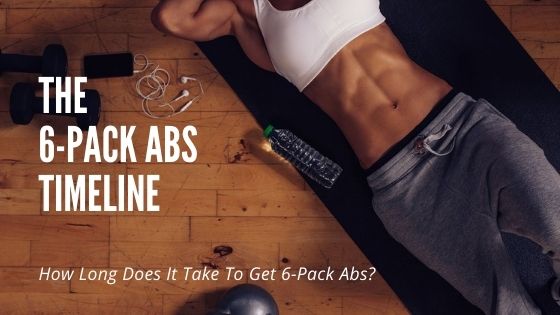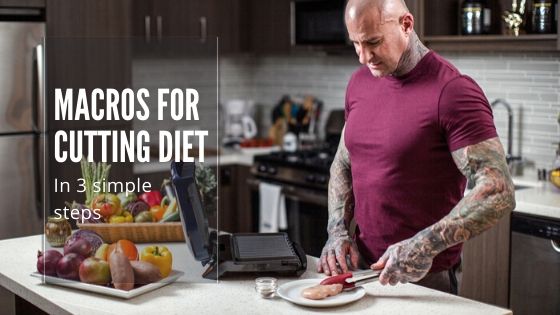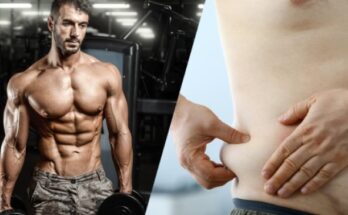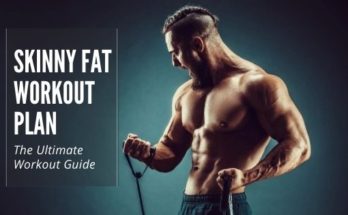We all dream of getting a well defined and chiseled 6-pack abs. But how long does it take to get those ripped abs? and how we can speed up the process to get abs fast?
You’ll get many articles and videos claiming “do this to get abs fast” or “how to get abs in a week” etc. Beware of these scams. It’s not that easy and obviously, not a one week process to get chiseled abs. So let’s have a look at what science says.
How Long Does It Really Take To Get Abs?
Well, there’s no fixed answer to this question. The time it will take you to reach your 6-pack abs goal depends mainly on two factors –
- How well trained your abdominal muscles are and
- The amount of fat over your muscles.
The more fat you have on your belly, the longer it will take to shed it and then to get your ripped abs visible.
How much FAT should you have to get your abs visible?
Due to hormonal differences, men and women require different body fat percentages. Men need less body fat and have more muscle mass naturally (thanks to testosterone).
According to the American Council on Exercise (ACE),
Men should have 6 to 13 percent and women should have 14 to 20 percent of body fat to get their midsection muscles pop out.
Going below 10 percent body fat looks very aesthetic and attractive but it’s not easy. It takes a lot of discipline and dedication to reach and maintain that level.
Here’s a chart from the American Council on Exercise showing different body fat percentages on the basis of category and gender:
| Category | Men | Women |
| Essential fat | 2%–5% | 10%–13% |
| Athletes | 6%–13% | 14%–20% |
| Fitness | 14%–17% | 21%–24% |
| Average | 18%–24% | 25%–31% |
| Obese | 25% and above | 32% and above |
The Six-Pack Abs Timeline
Let’s have a look at how long it might take to get those ripped abs based on the fat percentage you have.
Obese
Men – At least 8 months | Women – At least 1 year
At this level, you won’t be able to see any muscle definition and you may have the risk of various health problems.
If you are starting your six-pack journey from this point then it would take no less than 1-2 years to get ripped, especially if you have above 40% of your body fat.
However, if you have about 25-30 percent body fat and you’re dedicated enough then you can reach your goal within 8-10 months.
Average
If you have an average body fat percentage, then you would take about 6 months to get abs. However, if you play your cards perfectly, then you can get a ripped midsection in only about 4 months.
Fitness
At this level, you are not very far from your goal. You might already see some muscle definition in your arms, legs, and other body parts. Now you just need to reduce some more fat.
Probably you just need 2-3 months of hard work to get your abs visible. Depending on your body type, it might take some more time but you’ll definitely get to see the results of your hard work and dedication.
Athlete
In this category, you have the ideal body fat percentage to see your defined 6-pack abs. If you still can’t see your abs then it just a matter of a few weeks.
Start your cutting diet today and at max after a month, you’ll see your ripped abs popping out of your skin.
Make sure to not go below this level, unless you’re preparing for some bodybuilding competition. As some fat is essential for good health.
| Category | Average Time |
|---|---|
| Obese | 1-2 year |
| Average | 6 months |
| Fitness | 2-3 months |
| Athlete | Few days/weeks |
These are just the average time periods you would take to get ripped abs as per the amount of fat you have. You can get results faster or later than that depending on your dedication, hard work, and, consistency. As it’s all about the work you put in.
What You Should do to Get Abs Fast?
It’s true that there’s no magic pill or short cut to this. But here’re some things you can do to fasten the process.
How To Train
Hit every single muscle of your abs
To get a well-defined midsection, you have to train all the abdominal muscles with enough intensity. Only crunches and sit-ups are not enough to hit all the muscles.
Here’s the anatomy of your abdominal muscles.
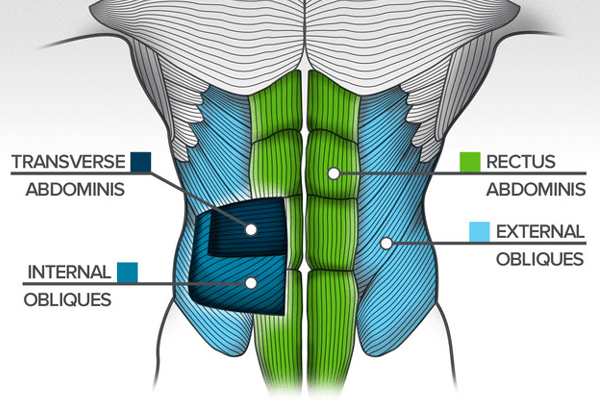
Rectus Abdominis: Running vertically in the center part which popularly called six-packs.
Transverse Abdominis: These are the lateral muscles found around the waist.
External Obliques: Running diagonally downward in the side region.
Internal Obliques: Running diagonally upward, underneath the external obliques.
To get a well defined mid-section, you have to hit all these muscles with enough intensity.
Don’t over train your abs
Training your abs daily with too much intensity won’t help in getting abs faster. Remember, similar to other body muscles, abs also need rest to recover and grow.
Hence, 3-4 sessions in a week of about 15-30 minutes are sufficient to train your abs properly.
Do Resistance Training
Don’t just keep doing cardiovascular exercises. Add resistance training to your workout routine to get better fat loss benefits. This will also help in building some muscles and increasing metabolism which further helps in burning more calories.
A study done on overweight adolescents found that those who did 30 min cardio and 30 min weight training 3 times a week, lose more fat than those who only did cardio.
Read more: Cardio vs Weights: Which is Better to Burn Fat?
HIIT
Add high-intensity interval training to your routine. In an equal time interval, HIIT burns more calories than steady-state cardio. This also gives you a metabolic boost which leads to more fat loss.
What To Eat
Intense training won’t give you appropriate results unless it is backed by proper nutrition. Here’re some nutrition tips that can help you in meeting your abs goal.
Eat in Calorie Deficit
Calorie deficit simply means eat less than you need to maintain your body weight. To lose one pound of fat per week you have to cut 500 calories per day.
You can do this by consuming fewer calories through diet and burning more calories through exercise.
Read More: How To Set Macros For Cutting Diet?
Cut sugar
Try to remove added sugar completely from your diet or eat as low as you can. Soft drinks, chocolate bars, pastries, packed juices, sauces, energy drinks, etc. are all no-no.
Eat more fiber
Fiber is one of the most under-rated nutrient of a healthy meal plan. Maybe this is the reason that a lot of Americans are not getting enough fiber.
Fiber is important for proper digestion of food and takes longer time to digest. Hence, helps in eating less calories throughout the day.
Fruits, vegetables, whole grains, beans, and legumes are all rich in fiber. Try to add some servings of these foods to your daily diet.
Eat enough protein
Protein is an essential macronutrient to build muscles. While doing fat loss, you may lose some amount of muscle mass too. Hence keep your protein intake high enough to support and build muscles.
Aim to take around 0.8-1.2 grams of protein per pound of body weight.
On top of that, protein helps in suppressing hunger and takes more time to digest which further helps in reducing your overall calorie intake.
Eat complex carbs
Complex carbohydrates take more time to digest than simple ones. They also contain more fiber too. Whole grains, legumes, brown rice, green vegetables, rolled oats, etc. are all rich in complex carbohydrates.
Hence, replacing simple carbs with complex carbs can also help in reducing your daily calorie intake.
Thank you for reading so far. I hope it cleared your confusion and you have learned something from it. If you have any queries please mention them in the comment section.

